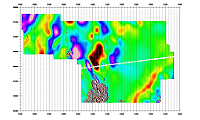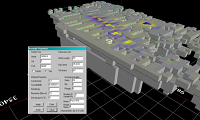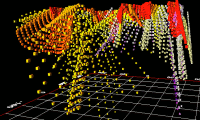![]() EMIGMA for Magnetics Product Description
EMIGMA for Magnetics Product Description
Download Magnetics demo database
(demo databases work with our EMIGMA Demo)
Magnetics geophysical interpretation is available in the EMIGMA Complete and EMIGMA for Ground Complete software packages, as a standalone product or as an add-on to other EMIGMA software licenses.
Airborne and Borehole Magnetics is supported by the Premium Series only.
With QCTool added, complete processing features, data QC/QA and mapping capabilities become available to the user, in addition to the modeling and inversion features of EMIGMA.
Magnetic compensation package available with QCTool for fixed-wing airborne applications.
Unlimited Survey Size!
True relational database design supports many unique features:
- Allows entire project(s) in one database
- Multiple surveys with different survey designs in one database
- Three levels of data organization
- Complete easy-to-access integration of survey data, maps, grids, models and simulated (modeled) data - all in a single database
State-of-the-art inversion algorithms!
Data Import
- DC Magnetic data - Total field, vector data and Magnetic Gradients
- Instrument formats
- QCTool format with additional support for a large variety of manufacturer and industry formats (See Product Description for a complete list.)
- Ground, Airborne and Total field or 3-component Borehole data (with derotation)
Data Processing
- Diurnal correction
- IGRF corrections
- Tie line corrections
- Gradient removal
- 2D FFT tools for:
- Tapered Tukey filtering
- Wavelength/wave number filtering
- Upward/downward continuation
- Derivative generation
- Reduction-to-the-Pole (4 approaches including 3 for low latitudes)
- Analytic Signal displays and output
- Horizontal Analytic Signal displays and output
- 1D, 2D spatial digital filters
- Data correction and survey planning tools
Data Display and Analyses
- 2D maps with under/overlays with transparency
- 3D surfaces (contoured and B&W)
- 3D Visualizer
- Gridding with 5 algorithms: Natural Neighbor, Delaunay Triangulation, Shepard, Minimum Curvature and
Thin-Plate-Splines - FFT grids (with user-defined aspect ratio)
- Line Plots - The most sophisticated geophysical plotting tool available.
- Plotting of model residuals
- Grid differencing
3D Modeling
EMIGMA offers traditional magnetic modeling via an internal magnetization vector parallel to the Earths' field but this is only the beginning of its extensive modeling capabilities.
Our magnetic LN algorithm is an extension to the current gathering LN algorithm for prisms or polyhedra to include magnetic field gathering effects due to induced magnetization.
This implementation of DC magnetic modeling is unlike the majority of techniques available at present. By extending the LN technique to magnetic effects, we are able to model interactions not only between multiple bodies, but also within a single body (so-called demagnetization effects).
Magnetic body interactions are also allowed with the traditional, internal weak (Born) induced field. The inclusion of remanent magnetization is also allowed.
All techniques are rapid in 3D as the responses are solved analytically thus providing extremely precise solutions for total field, vectors or derivatives.
Some of the key features include:
- Modeling of large data sets
- Fast and accurate 3D or 2D (long strike) simulations including model suite generation and batch mode features
- Unlimited prism and polyhedra targets
NEW Polyhedra: pipes (hollow cylinders with or without lids), ellipsoids, shells, bullets, landmines, drums, spheres, general polyhedra... - Geophysical model building tool in 3D space
- Easy import of models from DXF (AutoCAD), ASC (Vulcan) and STR (Surpac) formats and 'export' to these formats - NEW FEATURE
- Applications for UXO, Engineering and Archeological studies as well as Geotechnical investigations
- Accurate for both small and large susceptibilities
- Permanent magnetization effects
- Magnetic body interactions with multiple options
- Non-linear effects, demagnetization, magnetic channeling, remanent effects
- Direct, quasi-analytic derivative calculation
- Topography effects AND many more advanced features...
3D Magnetic Inversion
- 3D volume modeling of susceptibility with linear and non-linear inversion tools:
- Optimization & Direct Matrix Inversion
- Physical sensitivity functions
- Suite of minimization techniques
- Sensitivity to geological structures
- Inclusion of structures within topography
- Inclusion of topographic effect
- Removal of non-susceptible cells
- Full 3D gridded inversions
- Inversion cells with user-defined dimensions including varying thickness of cells with depth
- Data extrapolation with cell removal - NEW FEATURE
- Use of derivatives in inversion
- Utilization of preliminary forward models as starting models
- Inversion cells within topography
- Multiple inversion techniques including constrained approach for fast processing AND a host of unique features available only with EMIGMA...
Gradients
- Derivation of FFT gradients
- Modeling and Inversion of gradients
- Enhanced contouring with horizontal gradients
- Use of measured or processed data for depth estimation
3D Extended Euler Deconvolution
- 3D Euler solutions for profile and gridded data
- 2D and 3D visualization of Euler solutions
- Statistical and Rodin post-processing
- Unique Clustering algorithm
AND other depth estimation features







